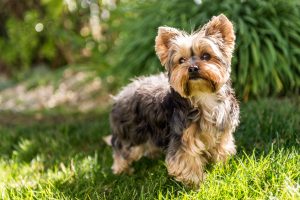Yorkshire Terrier
Breed description
Known for its glossy, long, steel-blue coat, the Yorkshire Terrier has evolved from a keen worker, to primarily a show and companion dog who is now more accustomed to living life indoors, as part of the family. Affectionately known as the Yorkie, the breed came about from crosses of other terriers that accompanied their owners migrating to Yorkshire at the height of the industrial revolution. These nimble dogs were used to keep mines and textile mills free of rats and mice through the 1800s, and were famed for being brave, bold and agile.
The breed may alternatively be black and tan, and it maintains its terrier gumption today. Nowadays it is mostly a lapdog, it has an oversized personality and a quirky, playful nature, providing owners with many years of joy and love.
Pros
- Generally friendly dogs
- Playful, fun and inquisitive
- Don’t require large amounts of exercise
- Small size so good companions for small houses or apartments
Cons
- Tend to suffer poor dental health
- Risk of breed associated health problems like tracheal collapse and luxating patella
- Have a tendency to bark
- Moderate amount of coat care is required
Suitable for
Although the Yorkie was traditionally bred to work, it’s not generally used for rodent control these days and is more than happy to be a house and family dog. Although caution must be exercised with all pets around little ones, they tend to make good pets for families with children. Whilst it doesn’t require hours of walks each day, the Yorkshire Terrier still needs a couple of daily walks and stimulation to keep it happy and prevent any unwanted frustration behaviours from developing – like chewing, excessive barking or overactivity in the house. They love to play and aim to please when trained appropriately.
- Can make a good family pet
- Ideal for apartment or small house with limited outdoor space
- Good companion for older couples
The Yorkshire Terrier could be an ideal companion for an older couple or individual.
Breed care advice
The long, fine coat does need some care to keep any Yorkie comfortable and neat. It’s prone to tangling up if it’s left long, so daily brushing help keeps it shiny and smoothed through. They can benefit from a trim to keep the length under control, or, if it’s left long, a regular bath to keep on top of any dirt accumulating in the fur of their tummies. Equally, keeping the fur trimmed around the face can help prevent eye gunk from getting matted up in the fur and keep the eyes nice and clean. Similarly, because these dogs aren’t the most active, their nails can easily get overly long, for some just their regular walks will help maintain a healthy nail length, but for others they won’t wear fast enough and will need trimming back a bit to avoid causing problems.
These dogs are very prone to dental disease, meaning that it’s important to get them used to having their teeth brushed from a young age. Early brushing will make regular tooth brushing as an adult much easier and can help prevent more severe dental disease. That said, it’s important to have their teeth checked regularly by the vet, no less than at their annual health check, to make sure any gingivitis or plaque accumulation can be found and treated early on.
Known health problems
Yorkshires can have very long life-expectancies, often living well into their teens. Aside from dental problems, some individuals may suffer from other health problems.
Tracheal collapse is common in small breed dogs such as Yorkies. Here, the trachea is abnormally soft making it collapse inwards as the dog breathes. It can be present to varying degrees, in severe cases we often see a startling, ‘goose-honking’ sounding cough and severe breathing difficulty. Depending on how severely the dog is affected, no treatment may be necessary, conservative medical management could be sufficient, or surgery to place a stent to hold the airway open may even be advised. In any case, it’s advisable that these dogs be walked using a harness not a collar, to avoid pressure on the trachea, they should avoid getting too hot or over-excited and owners should be aware that their disease may progress with time.
- Dental disease
- Tracheal collapse
- Degenerative mitral valve disease (DMVD) – in older, small-breed dogs, it is common to see infiltration of the mitral valve with excess tissue leading to leakiness and a murmur. Some dogs might progress to heart failure and need medical management to help control congestion (fluid accumulation in the lungs) and help the heart to function
- Luxating patella – often indicated by a skipping gait of the hindlegs, the Yorkshire Terrier often has an abnormally shaped femur where the kneecap (patella) sits, this makes it susceptible to slipping out of position and, in time, can lead to arthritis
- Protein losing enteropathy – some Yorkshires have inflammatory bowel disease where we see weight loss, diarrhoea and vomiting, and it’s often accompanied by abnormally low protein levels because of leaking in the intestines. It can take some investigation to get to the bottom of, extensive treatment and, in some dogs, it can be hard to manage
- Portosystemic shunts – some Yorkies have abnormalities in the blood flow from the intestines through the liver and back to the heart. Instead of going through the liver, blood can bypass it, allowing toxic substances to circulate and reach the brain, which can lead to neurological signs like seizures or head-pressing. Dogs might need surgery or medication to manage the condition, and each case is unique so the appropriate treatment varies from dog to dog.
Lead author: Yvette Bell MRCVS
